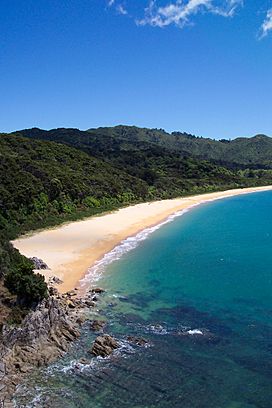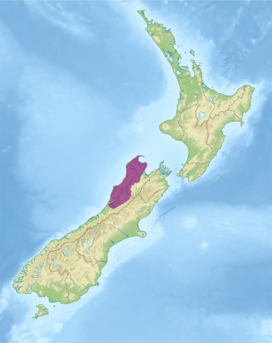Nelson Coast temperate forests facts for kids
Quick facts for kids Nelson Coast temperate forests |
|
|---|---|

Beach and forest in Abel Tasman National Park
|
|

Ecoregion territory (in purple)
|
|
| Ecology | |
| Realm | Australasian |
| Biome | temperate broadleaf and mixed forests |
| Borders | Richmond temperate forests, Southland montane grasslands, and Westland temperate forests |
| Geography | |
| Area | 14,451 km2 (5,580 sq mi) |
| Country | New Zealand |
| Regions | Tasman and West Coast |
| Conservation | |
| Protected | 11,407 km² (79%) |
The Nelson Coast temperate forests is a special natural area, or ecoregion, found in New Zealand. It's like a big natural neighborhood with its own unique plants and animals.
Contents
Where These Forests Are Found
These amazing forests are located on the sides of the Paparoa Range and other mountains at the top of New Zealand's South Island. This area gets a lot of rain, especially on the western slopes. The eastern side is more sheltered and has beautiful golden sand beaches.
The region is home to some cool natural spots. You can find the limestone Pancake Rocks near the town of Punakaiki, right next to Paparoa National Park. There's also Farewell Spit at the very north of the island, which is the longest sandspit in New Zealand. Nearby are the clear Te Waikoropupu Springs. You can also explore the unique karst areas on the sides of Mount Owen (New Zealand) in Kahurangi National Park.
Plants of the Nelson Coast
Near the coast, you'll find small patches of special trees like northern rata (Metrosideros robusta), rimu, and miro. These are rainforest hardwoods. You'll also see karaka (Corynocarpus laevigatus) and the Nikau palm (Rhopalostylis sapida).
Most of the area is covered in Southern beech forests. You can find all four types of Southern beech here: red beech, silver beech, and hard beech in the lower areas. Higher up, you'll see mountain beech.
In places where the rocks are less fertile, there are yellow pine (Halocarpus biformis) and Dracophyllum plants. This includes the D. townsonii, which is only found here, and the mountain neinei (D. traversii). Some alpine plants, like Celmisia dallii, grow on these peaks. This is because these mountains, along with Fiordland at the southern end of the island, were safe places for plants during the last ice age.
Animals of the Nelson Coast
These forests are home to many endemic species, meaning they are found only here. This includes two birds that cannot fly and are no longer found in the lower parts of the island. These are the western weka and the largest type of kiwi, the great spotted kiwi.
The different habitats in the region support a mix of other birds. You might spot the clever kea, the New Zealand kaka parrot (Nestor meridionalis), the New Zealand pigeon or kereru (Hemiphaga novaeseelandiae), and the fast New Zealand falcon or karearea (Falco novaeseelandiae). Farewell Spit is especially important for wading birds and is a stop on their migration route.
The area also has many invertebrates, which are animals without backbones. This includes almost half of all known types of amber snails (Powelliphanta).
Protecting These Forests
The forests face dangers from logging (cutting down trees) and mining. However, it's very hard to get permission for large-scale mining in Kahurangi National Park. The karst limestone areas are very delicate and can even be damaged by people exploring caves for fun.
The wildlife is also threatened by introduced species – animals brought to New Zealand by people. Luckily, at higher elevations, the wildlife is mostly safe. A large part of this ecoregion is protected within three national parks: the big Kahurangi National Park and Paparoa National Park on the west coast, and Abel Tasman National Park on the northeast coast.
The coastline is also beautiful and untouched. Some parts, including Farewell Spit, are protected as nature reserves or national parks. People are working hard to control the introduced animals that cause harm. Possums are a big target, but deer, chamois, hares, and goats are also controlled. Birds' eggs and snails are in danger from rats, possums, stoats, and wild pigs. Forest fires are also a constant threat to these precious forests.
See also
 In Spanish: Bosques templados de la costa de Nelson para niños
In Spanish: Bosques templados de la costa de Nelson para niños


